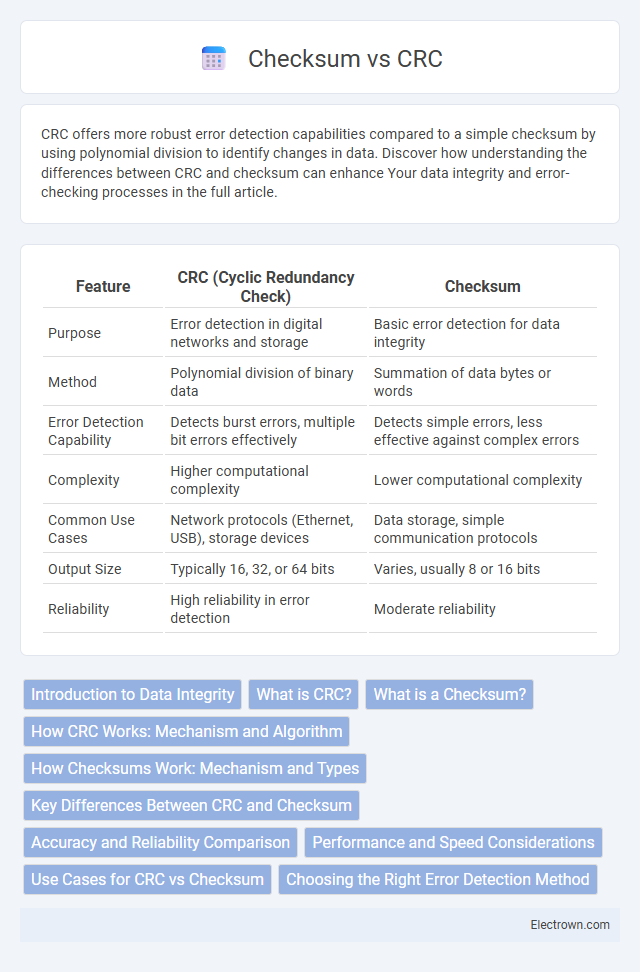CRC offers more robust error detection capabilities compared to a simple checksum by using polynomial division to identify changes in data. Discover how understanding the differences between CRC and checksum can enhance Your data integrity and error-checking processes in the full article.
Table of Comparison
| Feature | CRC (Cyclic Redundancy Check) | Checksum |
|---|---|---|
| Purpose | Error detection in digital networks and storage | Basic error detection for data integrity |
| Method | Polynomial division of binary data | Summation of data bytes or words |
| Error Detection Capability | Detects burst errors, multiple bit errors effectively | Detects simple errors, less effective against complex errors |
| Complexity | Higher computational complexity | Lower computational complexity |
| Common Use Cases | Network protocols (Ethernet, USB), storage devices | Data storage, simple communication protocols |
| Output Size | Typically 16, 32, or 64 bits | Varies, usually 8 or 16 bits |
| Reliability | High reliability in error detection | Moderate reliability |
Introduction to Data Integrity
CRC (Cyclic Redundancy Check) and Checksum are essential techniques for ensuring data integrity during transmission and storage. CRC uses polynomial division to detect a wide range of errors, providing higher reliability compared to simple checksum methods, which typically sum data values to verify accuracy. Both methods play critical roles in identifying corruption, with CRC favored in network communications and storage devices for its robustness.
What is CRC?
CRC (Cyclic Redundancy Check) is an error-detecting code used to identify accidental changes to raw data in digital networks and storage devices. It performs a polynomial division of the data's binary representation, generating a unique checksum based on the remainder, which helps verify data integrity. You can rely on CRC for more robust and reliable error detection compared to simple checksums.
What is a Checksum?
A checksum is a value calculated from a data set to detect errors during transmission or storage by summing the binary data and producing a fixed-size result. Unlike CRC (Cyclic Redundancy Check), which uses polynomial division to generate a more robust error-detection code, a checksum is simpler and typically less reliable in catching complex data corruption. Your system uses checksums to quickly verify data integrity, especially where speed is critical and minor error detection is sufficient.
How CRC Works: Mechanism and Algorithm
Cyclic Redundancy Check (CRC) works by treating data as a polynomial and dividing it by a predetermined generator polynomial using binary division. The remainder of this division becomes the CRC value, which is appended to the data for error detection during transmission or storage. Your system uses this mechanism to detect accidental changes in raw data with higher accuracy compared to simple checksum algorithms.
How Checksums Work: Mechanism and Types
Checksums operate by summing up the binary data within a packet or file to generate a value used for error detection during data transmission or storage. Common types include simple additive checksums, cyclic redundancy checks (CRC), and cryptographic hash functions, each varying in complexity and error-detection capabilities. You rely on checksums to quickly verify data integrity by comparing the calculated checksum with the original, ensuring accurate data communication.
Key Differences Between CRC and Checksum
CRC (Cyclic Redundancy Check) provides more robust error detection by using polynomial division, while a checksum sums data values to detect errors. CRC can detect burst errors and is widely used in network communications and storage devices, whereas checksums are simpler and faster but less reliable for complex error patterns. Your choice between CRC and checksum should consider the required level of error detection reliability and computational resources.
Accuracy and Reliability Comparison
CRC (Cyclic Redundancy Check) offers higher accuracy and reliability compared to checksum due to its robust polynomial-based algorithm, which detects a wider range of error types, including burst errors. Checksums are simpler and faster but less effective at identifying complex data corruptions, making CRC the preferred choice in critical data transmission and storage systems. Consequently, CRC ensures enhanced data integrity in communication protocols and file systems, outperforming checksum in error-detection capabilities.
Performance and Speed Considerations
CRC (Cyclic Redundancy Check) offers higher error-detection capabilities but generally requires more computational resources and time compared to a simple checksum. Checksums, using basic arithmetic operations, provide faster performance and lower latency, making them suitable for applications where speed is critical and error detection can be less rigorous. Hardware acceleration can significantly improve CRC speed, while checksums remain advantageous for their minimal processing overhead in resource-constrained environments.
Use Cases for CRC vs Checksum
CRC excels in detecting burst errors, making it ideal for network communications, digital storage devices, and file integrity verification where data accuracy is critical. Checksums are often used in simpler applications, such as error detection in small data transfers, software downloads, or initial data validation in embedded systems. Your choice depends on the required error detection strength: CRC provides higher reliability, while checksums offer faster computation for less critical data.
Choosing the Right Error Detection Method
CRC (Cyclic Redundancy Check) offers superior error detection capabilities compared to simple checksums, especially for detecting burst errors in data transmission. When high reliability and error resilience are critical, CRC is the preferred method due to its mathematical rigor and ability to identify a wider range of error patterns. For less critical applications or where computational efficiency is prioritized, checksums provide a faster, though less robust, error detection solution.
CRC vs Checksum Infographic

 electrown.com
electrown.com